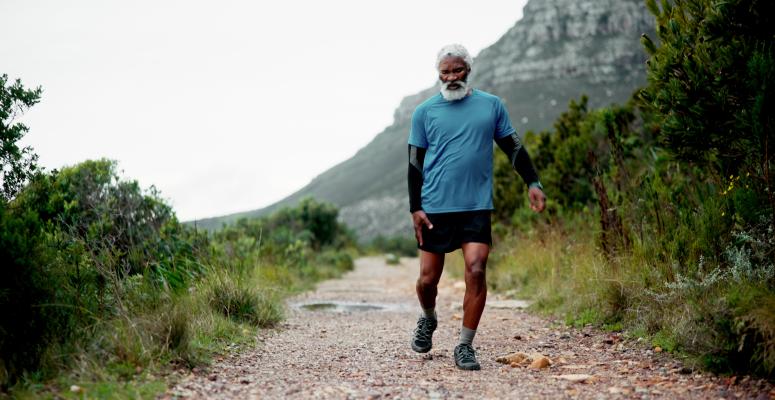
Hip bursitis is a painful condition that primarily affects women who are middle aged or older. It’s an overuse injury that often happens to people who are relatively active. Suddenly increasing the intensity of your exercise routine can cause hip bursitis to develop. For instance, people sometimes get this condition when they play a sport on weekends.
Hip bursitis is irritation and inflammation of the bursa that cushions the outside of the hip joint. Bursae are fluid-filled sacs that keep your joints moving smoothly and serve as shock absorbers. In addition to movement and intense exercise, hip bursitis can come about after an injury or surgery. People with conditions like rheumatoid arthritis, scoliosis or bone spurs may be more likely to develop it, as well as people who have one leg that’s longer than the other.
To recover from hip bursitis, you’ll need to take plenty of time to rest. This can be hard for people who like to stay active. However, the sooner your pain subsides, the sooner you can start increasing your activity.
In this article, we’ll discuss what types of exercise you should avoid while recovering from hip bursitis and some exercises that are safe.
What exercises should I avoid with hip bursitis?
If you have hip bursitis, you should avoid any exercises that put a lot of weight on the hip joints, such as weightlifting and high-impact exercises. Deep squats, straight-leg lifts and leg presses are particularly painful for people with hip bursitis. You should also avoid exercises with repetitive hip movements, which include most types of cardio. Running, cycling, stair climbing and ellipticals are all likely to aggravate hip bursitis.
7 exercises you should avoid while recovering from hip bursitis
After an initial period of rest, exercise will be an important part of your recovery and rehabilitation process. Don’t push yourself to do any exercises that cause you pain. You should wait until your pain has subsided and then slowly start with a few exercises that stretch out your hips and increase your range of motion. Strengthening and preventing reinjury will be among the last steps in your treatment plan.
Mild cases of hip bursitis should take a couple of weeks to recover from, and more severe cases may take up to a few months. You should see a physical therapist for a personalized treatment plan. Ask them about guidelines for safe exercise and therapeutic exercises to create some healthy movement in your hip joints while you’re healing.
Avoid these seven types of exercise to keep your pain to a minimum while recovering from hip bursitis:
- Deep squats — Deep squats should be avoided because they stretch the hip joints too far while also using them to support your upper body. If you want to give your quads and glutes a workout, wall sits are a good alternative. Stand with your back against a wall and bend your knees as if you’re sitting in a chair. Hold the position for up to a minute.
- Leg lifts — While some sources recommend isolated straight-leg lifts for recovering from hip bursitis, these put too much stress on the individual hip joints. Avoid them during the first several weeks of recovery, and talk with your physical therapist before adding leg lifts into your routine. Clamshells and side planks are gentler ways to work the outside of your hips and thighs. See instructions in the next section.
- Leg presses — Even if you reduce the amount of weight you lift, leg presses put a lot of strain on your hips because you flex and extend them while bearing weight. Most weight-bearing exercises for the legs will put some strain on your hips, so it’s best to avoid these while you’re recovering.
- Stair climbing — Stair climbing is harsh on the hip joints because you’re moving them in the same direction over and over again, supporting the full weight of your body. Walking is the best alternative for most cardio exercises for those with hip bursitis.
- Running — Running is a high-impact activity that requires your hips to move through nearly their full range of motion going forward and backward. Running even a short distance with hip bursitis can cause a lot of pain.
- Cycling — While cycling is a lower-impact activity for your knee and ankle joints, the repetitive movement in your hips can aggravate hip bursitis. Your quadriceps and hip flexors are also doing a lot of the work, which adds strain.
- Ellipticals — It may seem like ellipticals are a good low-impact option for exercising with hip bursitis. However, these machines can stretch your hip joints too far, and they still create repetitive movements.
What exercises are safe for hip bursitis?
So what exercises can you do while you’re waiting for hip bursitis to heal? For cardiovascular exercise, walking and swimming or water aerobics are some options that are gentler on your hip joints. Yoga is generally good because you’re holding the same pose for a longer period of time. However, certain poses and vinyasa flows may cause some pain. Talk with your physical therapist about yoga poses to avoid. Any stretches that work your hip flexors and rotators should be helpful. Ease into the stretch slowly, and stop doing any exercise that aggravates your pain.
Try the following exercises to stretch and strengthen your hips while recovering from hip bursitis:
- Clamshells — Lie on your side with your legs curled. You can prop your head up with the arm that’s closest to the floor. Keep your ankles together and slowly rotate your hip open so your knee is pointing to the ceiling. Lower it back down with control and repeat for up to 15 reps.
- Side planks — Lie on your side with your legs straightened. Maintain a straight line through your legs and hips as you prop yourself up on your forearm, bending your elbow at a 90-degree angle. You’ll feel this exercise in the side of your abdomen and the outside of your hip. Hold this pose for up to a minute and then switch sides.
- Glute bridges — Lying on your back, plant your feet on the floor so your knees are pointing up. Keep your hands at your sides, and slowly raise your hips so your back and torso are in a straight line. Hold this pose for up to a minute.
- IT band stretch — Stand next to a wall with your affected hip against the wall. Keep your weight on that foot and cross the other foot in front of it. Raise the arm closest to the wall and lean away from the wall, bending slightly at the waist. You should feel the stretch all through the affected hip.
Alliance PTP can connect you with the physical therapy practice you need for hip bursitis treatment
A physical therapist can provide safe and natural treatments to help you make a fast and complete recovery from hip bursitis. Your multiphase treatment will begin with passive treatments to stimulate soft tissue healing in your hip joint. Your PT will also create a personalized stretching and exercise program to help you rehabilitate.
Ready to see a physical therapist for hip bursitis? You’ll find plenty of options to choose from among the Alliance Physical Therapy Partners practices nationwide.
Still have questions about physical therapy for hip bursitis? Reach out today or find an Alliance PTP partner near you. Their friendly and knowledgeable local staff can help you find care for your hip bursitis.
Don’t have the time to see a physical therapist in person? Not a problem. Alliance PTP and its partners can also see you virtually in nearly every state.
Get Help at a Location Near You
